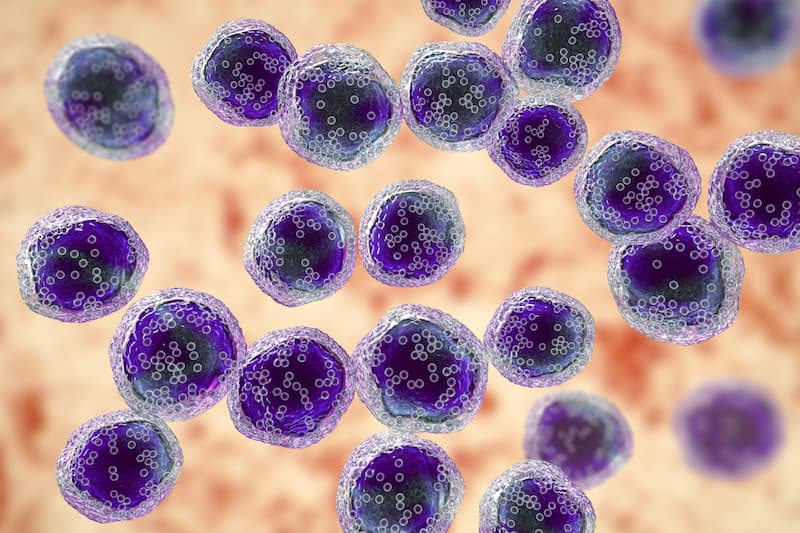Zanubrutinib Combo Improves ORR Vs Obinutuzumab in Follicular Lymphoma
The primary end point of overall response rate is met in the phase 2 ROSEWOOD study of patients with relapsed/refractory follicular lymphoma receiving zanubrutinib plus obinutuzumab vs obinutuzumab monotherapy.
"In a population of patients with [relapsed/refractory follicular lymphoma] previously treated with at least 2 lines of therapy, the combination of [zanubrutinib plus obinutuzumab] demonstrated a favorable risk/benefit profile and may represent a novel treatment option," according to the study authors.

Combining zanubrutinib (Brukinsa) with obinutuzumab (Gazyva) improved responses, produced meaningful clinical activity, and safety compared with obinutuzumab monotherapy in patients with relapsed/refractory follicular lymphoma, according to findings from the phase 2 ROSEWOOD study (NCT03332017).
The overall response rate (ORR) per independent central review (ICR) was 69% (95% CI, 61%-76%) in patients receiving zanubrutinib plus obinutuzumab compared with 46% (95% CI, 34%-58%) in those treated with obinutuzumab alone (P = .001). The complete response (CR) rate in each respective arm was 39% and 19% (P = .004). Additionally, investigators highlighted progressive disease within 12 months of completing the most recent line of therapy (no vs yes; odds ratio [OR], 4.7; 95% CI, 2.2-10.1; P <.001) and treatment arm (combination treatment vs monotherapy; OR, 2.7; 95% CI, 1.4-5.1; P = .002) as independent predictors of ORR per multivariate analysis.
In the combination and single-agent treatment arms, respectively, the median duration of response (DOR) per ICR was not evaluable (NE; 95% CI, 25.3 months-NE) vs 14.0 months (95% CI, 9.2-25.1), and that the 18-month DOR rates were 69% (95% CI, 58%-78%) vs 42% (95% CI, 23%-60%). Additionally, the median progression-free survival (PFS) by ICR was 28.0 months (95% CI, 16.1-NE) and 10.4 months (95% CI, 6.5-13.8) in each respective arm (HR, 0.50; 95% CI, 0.33-0.75; P <.001). Investigators also reported a median overall survival (OS) that was NE (95% CI, NE-NE) and 36.4 months (95% CI, 29.3-NE) in each arm (HR, 0.62; 95% CI, 0.35-1.07; P = .085); the 24-month rates were 77% (95% CI, 68%-84%) vs 71% (95% CI, 58%-81%).
“In a population of patients with [relapsed/refractory follicular lymphoma] previously treated with at least 2 lines of therapy, the combination of [zanubrutinib plus obinutuzumab] demonstrated a favorable risk/benefit profile and may represent a novel treatment option,” the study authors wrote. “In the context of the limited availability of effective low-toxicity therapeutic options for [relapsed/refractory follicular lymphoma, the] phase 3 [MAHOGANY] study [NCT05100862] of [zanubrutinib plus obinutuzumab] versus lenalidomide [Revlimid] plus rituximab [Rituxan] in this setting is now underway.”
In the ROSEWOOD study, patients were randomly assigned to receive 1000 mg of obinutuzumab intravenously on days 1, 8, and 15 of cycle 1 followed by day 1 of cycles 2 to 6 then once every 8 weeks with or without 160 mg of oral zanubrutinib twice a day. Patients in the single-agent arm were eligible to cross over to combination therapy in the event of progressive disease or stable disease after 12 months.
The study’s primary end point was ORR by PET-CT assessment based on Lugano 2014 classification for non-Hodgkin lymphoma. Secondary end points included DOR, PFS, OS, time to response, patient-reported outcomes, and toxicity.
Patients with grade 1, 2, or 3a follicular lymphoma according to World Health Organization 2008 criteria who received at least 2 prior systemic therapies for their disease, including an anti-CD20 antibody and an alkylating agent, were able to enroll on the trial. Additional eligibility criteria included having an ECOG performance status of 0 to 2, no prior exposure to Bruton tyrosine kinase inhibitors, and no sign of transformation to aggressive B-cell lymphoma.
The median age among all enrolled patients (n = 217) was 64.0 years (range, 31-88). In the combination therapy (n = 145) and monotherapy (n = 72) arms, respectively, most patients received 2 to 3 prior lines of therapy (72% and 75%), had Ann Arbor stage III to IV disease (82% and 83%), and were refractory to rituximab (54% and 50%).
At least 1 treatment-emergent adverse effect (AE) occurred in 94% of patients assigned to the combination therapy arm and 90% of those assigned to the monotherapy arm. The most common any-grade TEAEs in each respective arm included thrombocytopenia (36% and 24%), neutropenia (29% and 28%), diarrhea (18% and 17%), and fatigue (15% and 14%). Grade 3 or higher TEAEs affected 63% and 48% of patients in each respective arm, the most common of which included thrombocytopenia (15% and 7%), pneumonia (10% and 4%), and diarrhea (3% and 1%).
Investigators highlighted that 8% of patients receiving combination therapy and 10% of those receiving single-agent obinutuzumab experienced at least 1 TEAE resulting in death. Only 1 death in the monotherapy arm due to anaphylactic reaction following obinutuzumab infusion was found to be associated with the study treatment.
Reference
Zinzani PL, Mayer J, Flowers CR, et al. ROSEWOOD: A phase II randomized study of zanubrutinib plus obinutuzumab versus obinutuzumab monotherapy in patients with relapsed or refractory follicular lymphoma. J Clin Oncol. Published online July 28, 2023. doi:10.1200/JCO.23.00775
Highlighting Insights From the Marginal Zone Lymphoma Workshop
Clinicians outline the significance of the MZL Workshop, where a gathering of international experts in the field discussed updates in the disease state.